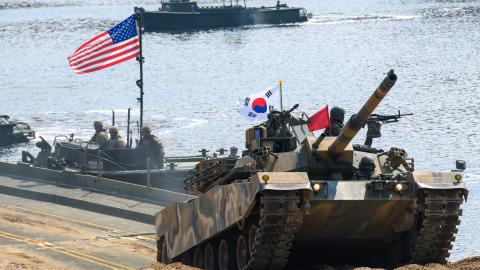Executive Summary
This report makes 10 recommendations for how to improve the United States–South Korea alliance, split evenly across security and economic domains. These concepts, proposals, and deals can be mutually reinforcing of the alliance and the overall bilateral relationship at a time of considerable international uncertainty.
Five Security Recommendations:
- Restore the warrior ethos and accelerate OPCON transition.
Both US and South Korean forces need to reinvigorate military discipline and readiness. They should increase joint training, improve combat effectiveness, and set a firm deadline for transferring wartime operational control (OPCON) to South Korea to reflect its growing self-defense capabilities. - Establish a “Golden Dome” missile defense consultative group.
The two countries should form a consultative body to co-develop next-generation, layered missile defense systems that integrate emerging technologies and lessons from recent conflicts. South Korea should strengthen its KAMD (Korea Air and Missile Defense) system and align efforts with the US Iron Dome for America initiative. - Forge a US–South Korea maritime power partnership.
Washington and Seoul should combine South Korea’s shipbuilding expertise with US naval modernization efforts. They should also expand joint production, reduce reliance on Chinese maritime supply chains, and co-develop autonomous vessels and maritime energy infrastructure to counterbalance China’s maritime dominance. - Expand alliance defense industrial base cooperation.
The allies should capitalize on South Korea’s defense manufacturing capabilities to co-produce precision munitions, expendable drones, and advanced military systems. And they should strengthen joint research and development projects, diversify supply chains, and position South Korea as a key supplier in global defense networks. - Establish a “3D” deterrence, defense, and diplomacy council.
The US and South Korea should create a high-level council to coordinate nuclear deterrence strategies, missile defense planning, and diplomatic initiatives. The countries should also enhance extended deterrence credibility, improve South Korea’s conventional retaliatory power, and manage inevitable tensions that arise from growing regional nuclear threats and questions about the American nuclear umbrella.
Five Economic Recommendations:
- Eliminate the trade imbalance.
The trading partners need to address America’s $66 billion trade deficit with South Korea by encouraging new investment in US industries like auto, steel, and semiconductors in exchange for tariff relief and strategic incentives. They should also consider renegotiating the Korea-US Free Trade Agreement (KORUS FTA) to promote balanced trade. - Increase investment in AI-driven data centers.
The countries should build joint artificial intelligence supercomputing hubs and promote bilateral investment in AI infrastructure. They can also integrate South Korean expertise into US-led initiatives like Stargate to ensure leadership in AI, large-language models, and high-performance cloud computing. - Strengthen energy cooperation through SMRs and LNG.
Washington and Seoul need to exploit US liquified natural gas (LNG) and allied capabilities in small modular reactors (SMRs) to power energy-intensive data centers. They should launch joint projects to deploy clean, resilient power infrastructure for AI ecosystems and digital industries. - Create an LNG energy corridor from Alaska into East Asia.
The allies should develop a strategic LNG corridor from Alaska to East Asia and the Indo-Pacific. They can combine US energy abundance with South Korea’s LNG shipbuilding prowess to build infrastructure that supports regional energy security and counterbalances unreliable energy sources. - Leverage chips and supply chains for advanced manufacturing and reindustrialization.
As America seeks transformation and the renewal of its industrial manufacturing capabilities, it should work more closely together with South Korea to bolster semiconductor chip manufacturing, harness AI, secure critical mineral supply chains, and reduce overreliance on Chinese industrial products.














